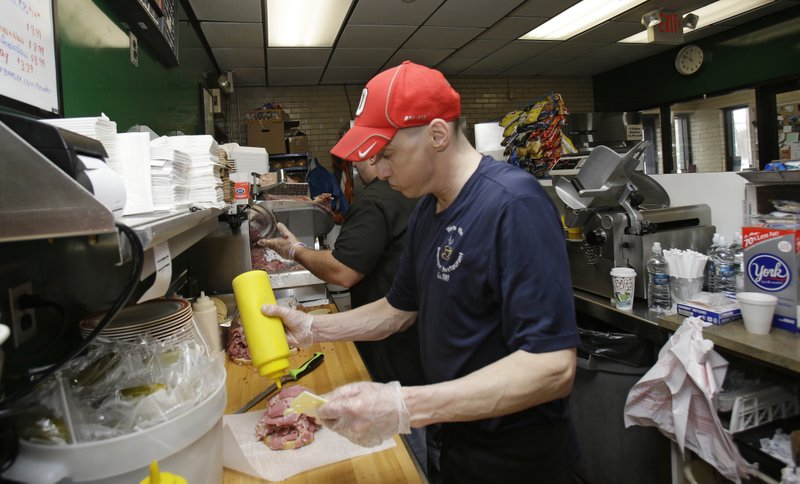WASHINGTON -- Growth picked up last month at U.S. service companies, which have been a source of strength for the American economy.
The Institute for Supply Management said Tuesday that its services index rebounded to 54.5 in March from a two-year low of 53.4 in February. Anything above 50 signals growth.
"The economy seems to be humming along pretty good here," Anthony Nieves, the institute's services survey chairman, said during a conference call Tuesday with reporters. "Now there's a little bit more confidence in the air" and hiring is expected to grow, he said.
Business activity and new orders grew faster in March. A measure of export orders surged to the highest level in a year. A measure of employment in services registered 50.3 after contracting in February.
Overall, "this is the best reading since December but still a far cry from the torrid figures seen through most of last year," Stephen Stanley, chief economist at Amherst Pierpont Securities, wrote in a research report. The index averaged 57.2 last year, he wrote.
The Institute for Supply Management is a trade group of purchasing managers. Its services survey covers businesses that employ the vast majority of workers, including retail, construction, health care and financial services companies.
Services have been a source of strength for the U.S. economy at a time when manufacturing has been hurt by weak demand for U.S. goods overseas and by a strong dollar that makes U.S. products more expensive. Consumer spending on services grew at a 2.8 percent annual pace from October through December, twice as fast as the overall economy expanded during those months. Hiring by services firms accounts for 90 percent of the 2.8 million jobs U.S. employers have added over the past year.
"The improvement should come as a relief to those who were concerned early in the year that the U.S. would slide into a recession," said Dana Saporta, a U.S. economist at Credit Suisse Securities USA in New York. "Those fears have diminished greatly. Recent U.S. economic data really don't look that bad. We have moderate growth despite continued head winds."
U.S. hiring jumped to a nine-year high in February, a sign of robust business demand for new workers, while the number of open positions slipped.
The Labor Department reported Tuesday that 5.4 million people found jobs, a 5.8 percent jump from January and the most since November 2006. More Americans also quit their jobs. Both figures point to a healthier, more dynamic labor market.
Businesses have been reluctant to accelerate hiring for much of the nearly 7-year-old recovery from a recession. But the raw hiring numbers have now returned to pre-recession levels. That suggests businesses are more confident about the economy's future.
"Just about any measure of labor-market conditions right now is showing strong conditions," said Robert Dye, chief economist at Comerica Inc. in Dallas. "I would expect month-to-month fluctuations, but we look for ongoing moderate to strong job growth this year, and that being a major support to consumers and a major support to the overall U.S. economy."
Tuesday's figures track total hiring. The monthly jobs report released last week calculates a net total of job gains after subtracting those who quit, retired or were laid off.
The latest jobs report showed that employers added a solid 215,000 positions in March, while the unemployment rate rose to 5 percent from 4.9 percent. Yet the increase in the rate occurred mostly for positive reasons: More Americans began hunting for jobs, though not all were immediately hired. That pushed up the number of unemployed despite the job gain.
Employers are adding jobs at a steady clip, even as the economy has shown some signs of slowing. Americans barely increased their spending in February for the third month in a row, holding back growth and pointing to ongoing caution despite the job gains.
Many analysts now expect the economy will expand at just a 1 percent annual rate or less in the first three months of this year, after a tepid 1.4 percent increase in last year's fourth quarter.
But employers' willingness to fill jobs suggests they see the slowdown as mostly temporary. Cheaper gasoline and modest wage gains are putting more money in Americans' pockets, which could improve spending and growth in the coming months.
The number of people quitting their jobs rose to a healthy 2.95 million in February, though that remained just below December's recent peak.
Workers typically quit when they have another job lined up, usually for higher pay. So more quitting is generally a good sign for the economy.
Information for this article was contributed by Paul Wiseman and Christopher S. Rugaber of The Associated Press and Shobhana Chandra and Michelle Jamrisko of Bloomberg News.
Business on 04/06/2016
